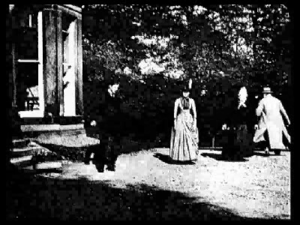Long Peace: Difference between revisions
No edit summary |
|||
| Line 21: | Line 21: | ||
==Terminology and periodisation== | ==Terminology and periodisation== | ||
The Long Peace strictly speaking is agreed to start with the conclusion of the [[War of the Triple Alliance]] in 1855. There is some debate among historians as to whether the end of the period should come in 1913 with the [[Great Collapse]], which marked a sharp decline in the standard of living and the end of political stability, or in 1916 with the start of the [[Kireno-Estmerish War]], which saw the end of Estmere's peace at home. Most historians support the former interpretation. The term Long Peace is an anachronistic term which has been applied to the era retroactively, contrasting the peace and prosperity of the era with the political turmoil, economic deprivation and conflict of the Great Collapse and the [[Great War (Kylaris)|Great War]]. | |||
The era spans across the reigns of three [[Monarchy of Estmere|monarchs]]; [[Edward III of Estmere|Edward III]] (who reigned from 1851 to 1871), [[Richard XII of Estmere|Richard XII]] (1871 to 1898) and [[Edward IV of Estmere|Edward IV]] (1898 to 1916). This has led some historians - mostly {{wp|royalist}}s - to split the era into the Third Edwardian era, the Twelfth Ricardian era and the Fourth Edwardian era. It is generally accepted by historians that most contemporaries used terms closer to these if they used any terms at all to describe the era they were living in. The Long Peace has also been divided into distinct periods by non-royalists. These are generally the High Peace from 1855 to the 1890s and the Low Peace from the 1890s to the end of the period. The High Peace is characterised by {{wp|liberalism}}, political reform and {{wp|suffrage}}, economic growth and {{wp|Realism (art movement)|Realism}}, while the Low Peace is characterised by increasing {{wp|legislative gridlock}}, rising {{wp|political extremism}}, economic slowdown and {{wp|Modernism}}. It is sometimes said that the lordly, liberal reformer the [[Sir Richard Hope, Earl of Longwood|Earl of Longwood]] epitomises the High Peace, while the common, populist radical [[John Harris]] epitomises the Low Peace. | |||
==Politics== | ==Politics== | ||
==Foreign affairs== | ==Foreign affairs== | ||
Revision as of 16:57, 17 April 2022
| Long Peace | |||
|---|---|---|---|
| 1855–1913 | |||
 | |||
| Location | Estmere | ||
| Including | |||
| Monarch(s) | Edward III, Richard XII, Edward IV | ||
| Leader(s) | Earl of Longwood, Baron Burke, Marquess Rhisling, Seymour Parnell, Earl of Tanqueray, Viscount Maraleigh, Marquess Ebrington, Baron Gorhambury, John Harris | ||
| |||
The Long Peace was an era of Estmerish history generally agreed to have lasted from the end of the War of the Triple Alliance in 1855 to the Great Collapse in 1913, though some historians extend the period until the beginning of the Kireno-Estmerish War in 1916. The Long Peace largely coincided with the Prachtvolle Epoche in Werania.
The period was named retroactively for the unprecedented peace which citizens of the Estmerish metropole enjoyed at the time, in comparison to the Euclean Spring which came before and the Great War which followed. During this peace, Estmere experienced relative internal political stability, which contrasted with the uncertainty of the Spring, while also seeing the worst of the Viridian Reaction reversed as parliament achieved ascendency over the monarchy and suffrage gradually expanded. Economically, the period was characterised by slow but steady economic growth, while culturally the Romanticists were eclipsed by new movements such as the Realists, with Morwall emerging as a cultural as well as industrial centre. Innovations such as motion picture also flourished.
Characterised by optimism, relative prosperity, innovation, peace at home and expansion abroad, the Long Peace is seen as a Golden Age, in stark contrast to the Great Collapse which followed.
Terminology and periodisation
The Long Peace strictly speaking is agreed to start with the conclusion of the War of the Triple Alliance in 1855. There is some debate among historians as to whether the end of the period should come in 1913 with the Great Collapse, which marked a sharp decline in the standard of living and the end of political stability, or in 1916 with the start of the Kireno-Estmerish War, which saw the end of Estmere's peace at home. Most historians support the former interpretation. The term Long Peace is an anachronistic term which has been applied to the era retroactively, contrasting the peace and prosperity of the era with the political turmoil, economic deprivation and conflict of the Great Collapse and the Great War.
The era spans across the reigns of three monarchs; Edward III (who reigned from 1851 to 1871), Richard XII (1871 to 1898) and Edward IV (1898 to 1916). This has led some historians - mostly royalists - to split the era into the Third Edwardian era, the Twelfth Ricardian era and the Fourth Edwardian era. It is generally accepted by historians that most contemporaries used terms closer to these if they used any terms at all to describe the era they were living in. The Long Peace has also been divided into distinct periods by non-royalists. These are generally the High Peace from 1855 to the 1890s and the Low Peace from the 1890s to the end of the period. The High Peace is characterised by liberalism, political reform and suffrage, economic growth and Realism, while the Low Peace is characterised by increasing legislative gridlock, rising political extremism, economic slowdown and Modernism. It is sometimes said that the lordly, liberal reformer the Earl of Longwood epitomises the High Peace, while the common, populist radical John Harris epitomises the Low Peace.